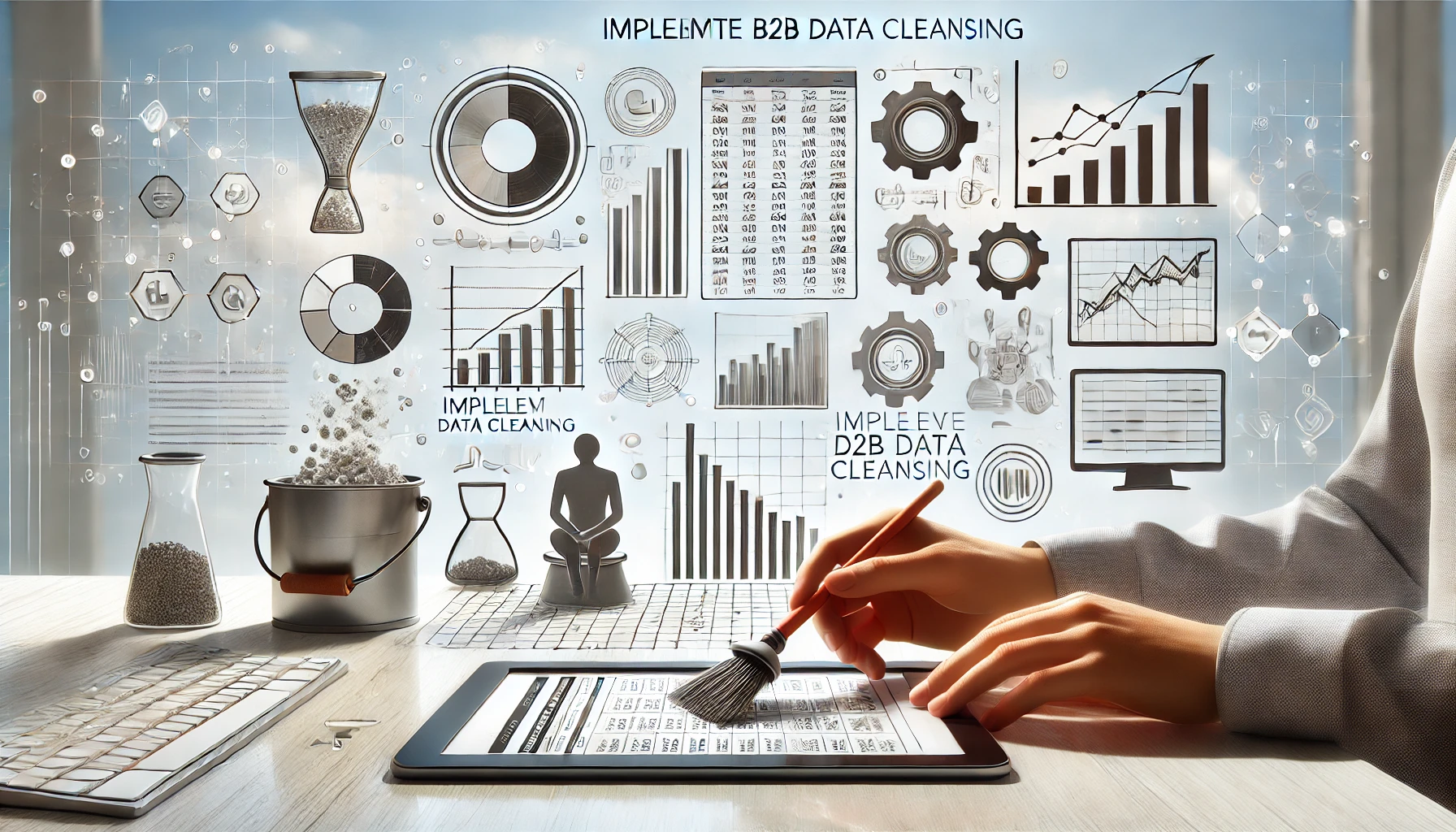To implement B2B data cleansing, think of it as sculpting a masterpiece from a block of marble – it requires precision, patience, and a keen eye for detail. Start by unraveling the complexities of your data landscape, uncovering hidden imperfections that might be hindering your business growth. But what comes next is where the real transformation happens. Stay tuned to discover the essential steps and strategies that will help you refine your data, streamline operations, and elevate your decision-making prowess in the competitive B2B realm.
Identify Inconsistencies
When embarking on the process of implementing B2B data cleansing, the initial crucial step is to meticulously identify inconsistencies within your existing datasets. Data profiling plays a vital role in this phase, allowing you to gain a comprehensive understanding of the quality and structure of your data. By conducting data profiling, you can uncover anomalies, missing values, and inconsistencies that may hinder the effectiveness of your cleansing efforts.
Once inconsistencies are identified through data profiling, the next step is data normalization. This process involves organizing and standardizing the data to ensure uniformity and consistency across all records. By normalizing the data, you can eliminate redundant information, correct errors, and align formats, making it easier to detect and rectify discrepancies.
Remove Duplicate Data
To effectively enhance the accuracy and efficiency of your B2B data, the crucial task of removing duplicate data must be meticulously executed. Duplicate data can lead to errors, misinformed decisions, and unnecessary costs. Start by conducting a thorough analysis of your database to identify duplicate records. Utilize data merging techniques to combine duplicate entries, ensuring that only one accurate and comprehensive record remains. When merging data, pay close attention to details such as contact information, company names, and addresses to ensure consistency across all merged records. Implement record matching algorithms to automate the process of identifying duplicates based on predefined criteria. Regularly perform data cleansing routines to prevent the accumulation of duplicate data in the future. By removing duplicate data through precise data merging and record matching, you will streamline operations, improve decision-making, and enhance the overall quality of your B2B database.
Correct Errors
To ensure the integrity and reliability of your B2B data, one crucial step is to correct any errors present in your database. Maintaining data integrity is vital for effective data cleansing. Here are five key actions to help you correct errors and enhance the quality of your B2B data:
- Identify Incorrect Entries: Scrutinize your database to pinpoint any inaccuracies or inconsistencies.
- Validate Information: Verify the accuracy of each data point by cross-referencing with reliable sources.
- Update Outdated Records: Keep information current by updating any outdated or obsolete data.
- Fix Formatting Issues: Standardize how data is presented to ensure consistency and readability.
- Implement Error-Checking Mechanisms: Set up automated processes to catch and rectify errors in real-time, enhancing data accuracy.
Standardize Data Formats
After ensuring the accuracy of your B2B data by identifying and correcting errors, the next step in the data cleansing process is to standardize data formats. This involves two key processes: data normalization and format validation.
Data normalization is the process of organizing data in a consistent and standardized way. It ensures that data is structured uniformly, making it easier to analyze and extract insights. By standardizing formats such as dates, addresses, and product information, you can streamline data management and enhance the overall quality of your database.
Format validation is equally crucial in maintaining data integrity. Validating formats involves confirming that data entries adhere to predefined rules and standards. This step helps identify inconsistencies or inaccuracies in the data, allowing for prompt corrections. For instance, validating email addresses to ensure they follow the standard format prevents errors in communication and marketing efforts.
Validate Data Accuracy
Now, it’s crucial to focus on validating the accuracy of your B2B data. Start by conducting a thorough data quality assessment to identify any inconsistencies or errors. This process will help ensure that your data is reliable and up-to-date for effective decision-making within your organization.
Data Quality Assessment
Ensuring the accuracy of your B2B data is crucial for the success of your business operations. To assess the quality of your data effectively, you can follow these steps:
- Data Profiling: Start by analyzing your data sources to understand the structure and quality of the information.
- Data Enrichment: Enhance your existing data by adding missing details or correcting inaccuracies to improve its overall quality.
- Duplicate Identification: Identify and remove duplicate entries to avoid errors and inconsistencies in your database.
- Consistency Check: Ensure that data across different systems or platforms is consistent and aligned to prevent discrepancies.
- Validity Verification: Validate the accuracy and relevance of your data by cross-referencing it with reliable sources or industry standards.
Error Identification Process
To effectively validate the accuracy of your B2B data, the Error Identification Process plays a vital role in ensuring data integrity and reliability. Data profiling is a key component in this process, involving the analysis of data to identify inconsistencies and errors. By thoroughly examining your data through data profiling techniques, you can uncover discrepancies such as missing information, duplicate entries, or outdated records. Additionally, data enrichment can further enhance the accuracy of your data by supplementing it with additional information from reputable sources.
During the Error Identification Process, it is essential to meticulously review each data point to pinpoint any inaccuracies. By conducting thorough checks and utilizing advanced tools, you can identify and rectify errors promptly. This meticulous approach ensures that your B2B data is clean, up-to-date, and accurate, enabling you to make informed business decisions based on reliable information. Through the diligent execution of the Error Identification Process, you can maintain the quality and trustworthiness of your B2B data.
Improve Data Quality
To enhance data quality, it’s crucial to implement robust data accuracy methods and employ effective data validation techniques. By ensuring the accuracy and validity of your B2B data, you can improve decision-making processes and drive business growth. Embracing these practices will help you maintain a clean and reliable database, ultimately leading to more successful outcomes for your organization.
Data Accuracy Methods
Improve the quality of your B2B data by implementing effective data accuracy methods. To enhance data accuracy, consider the following approaches:
- Regular Data Profiling: Conduct routine data profiling to analyze the quality, consistency, and completeness of your data.
- Implement Data Enrichment Tools: Utilize data enrichment tools to enhance existing data by adding missing information or updating outdated records.
- Standardize Data Formats: Ensure data accuracy by standardizing formats for names, addresses, and other key information.
- Remove Duplicate Entries: Identify and eliminate duplicate entries to maintain a clean and accurate database.
- Validate Data Sources: Verify the sources of your data to ensure reliability and accuracy in your B2B information.
Data Validation Techniques
Enhancing the quality of your B2B data requires a meticulous approach to data validation techniques. Data profiling is a fundamental step in data validation, involving the analysis of data to understand its structure, quality, and completeness. By conducting data profiling, you can identify inconsistencies, anomalies, and missing information within your dataset, enabling you to address these issues effectively.
Another crucial aspect of data validation is data enrichment, which involves enhancing your existing data with additional information from external sources. This process can help fill in gaps, correct inaccuracies, and improve the overall quality and completeness of your B2B data. By utilizing data enrichment techniques, you can ensure that your data is up-to-date, accurate, and relevant for your business needs.
Incorporating data validation techniques such as data profiling and data enrichment into your B2B data cleansing process is essential for maintaining high-quality data that drives informed decision-making and business success.
Frequently Asked Questions
How Often Should Data Cleansing Be Performed?
To maintain top-notch data quality, you should routinely perform data cleansing. Frequency analysis reveals that cleaning your data regularly ensures accuracy, efficiency, and reliable insights. Make it a habit to cleanse your data consistently.
What Tools Are Recommended for Data Cleansing?
For data cleansing, recommended tools include data validation software for accuracy and duplicate removal tools to ensure data integrity. Choose tools that streamline the process and provide detailed reports for comprehensive data cleansing.
Can Data Cleansing Improve Marketing ROI?
Improving data accuracy through cleansing can boost your marketing ROI. By enhancing campaign effectiveness with clean data, you can target the right audience, personalize messages, and optimize strategies for better results.
How Can Data Cleansing Impact Customer Relationships?
Data cleansing can significantly impact customer relationships. By ensuring accurate data, you enhance customer retention rates and improve sales forecasting accuracy. Clean data leads to targeted marketing efforts, personalized interactions, and ultimately, stronger customer loyalty.
What Are the Common Challenges in Data Cleansing Implementation?
In data cleansing, common challenges include ensuring data accuracy and maintaining time efficiency. Addressing these hurdles through streamlined processes and automated tools can enhance the effectiveness of your data cleansing implementation, fostering better business outcomes.




